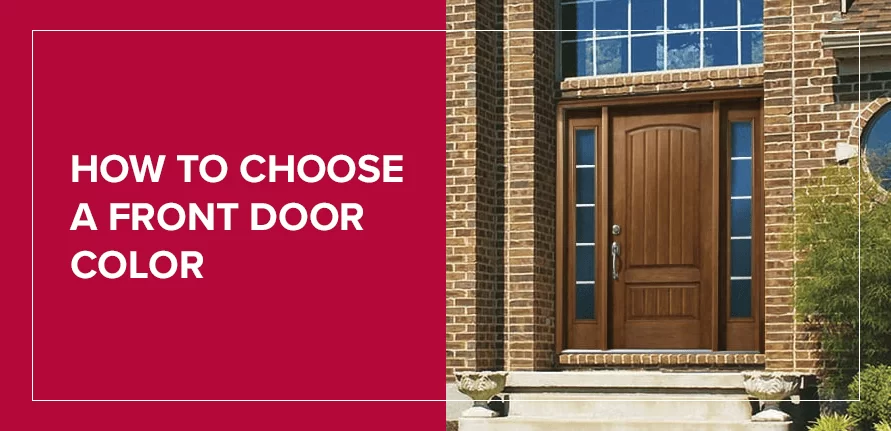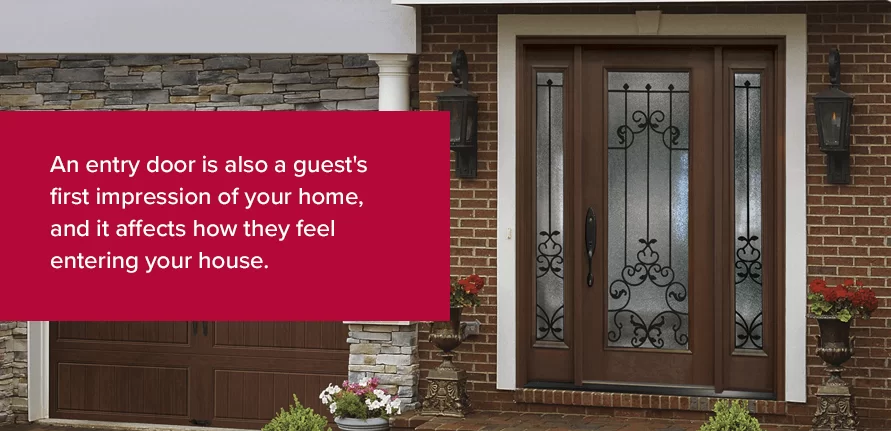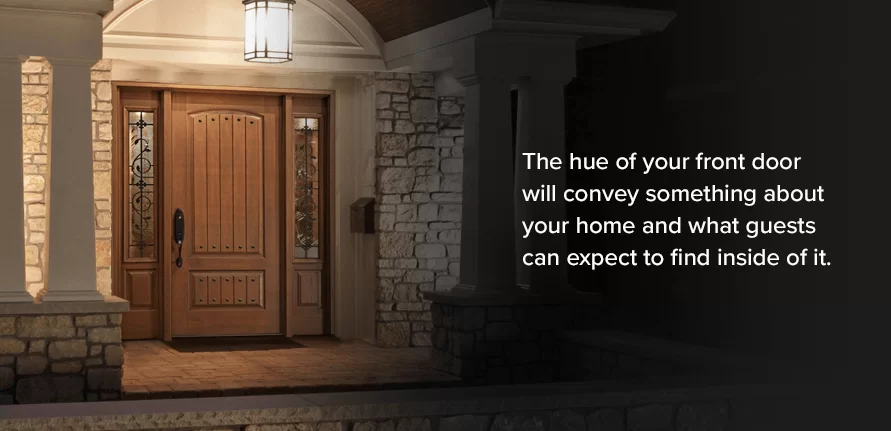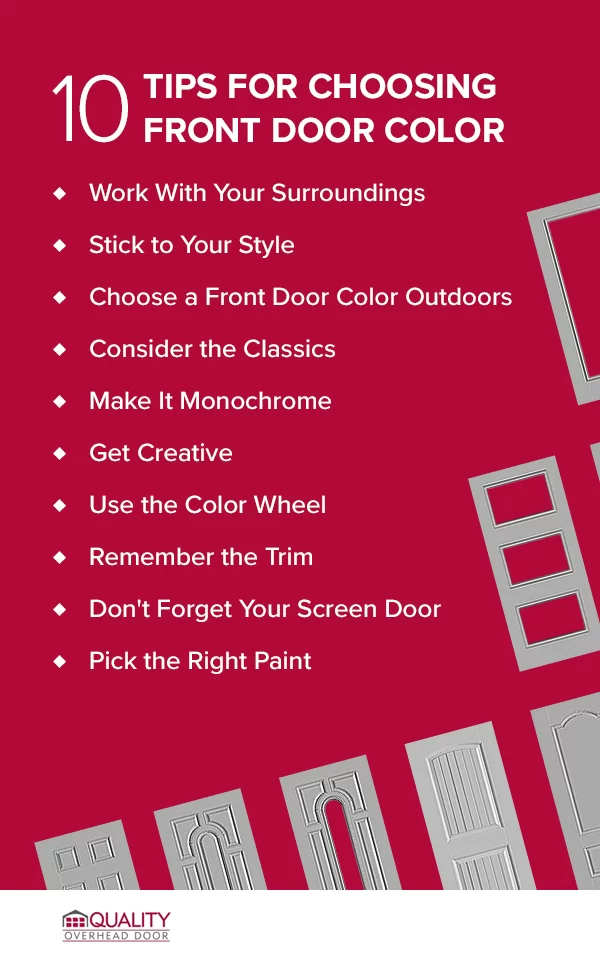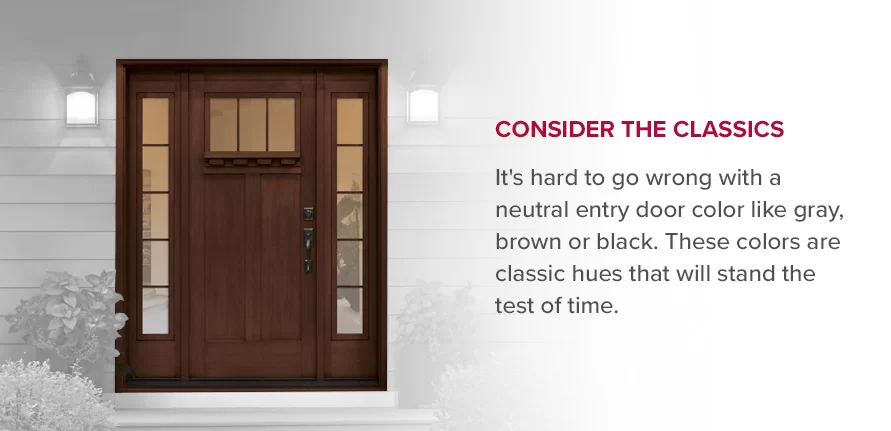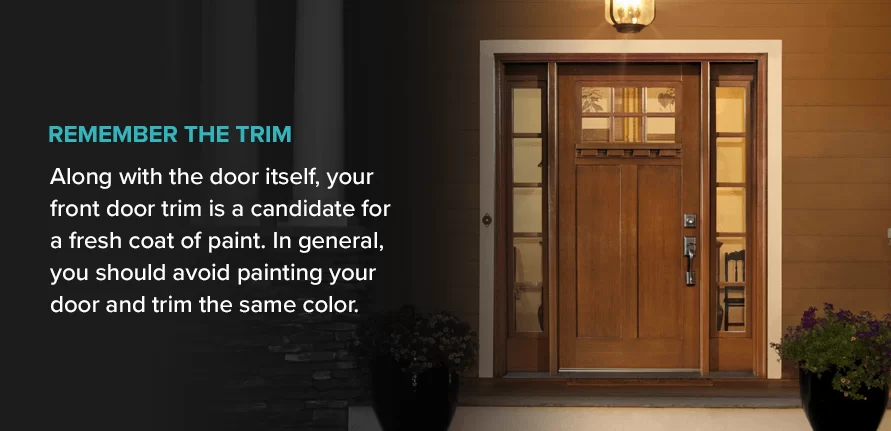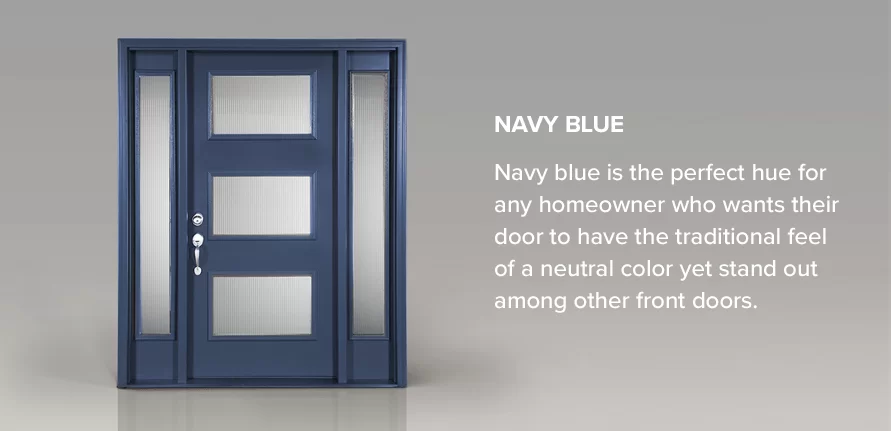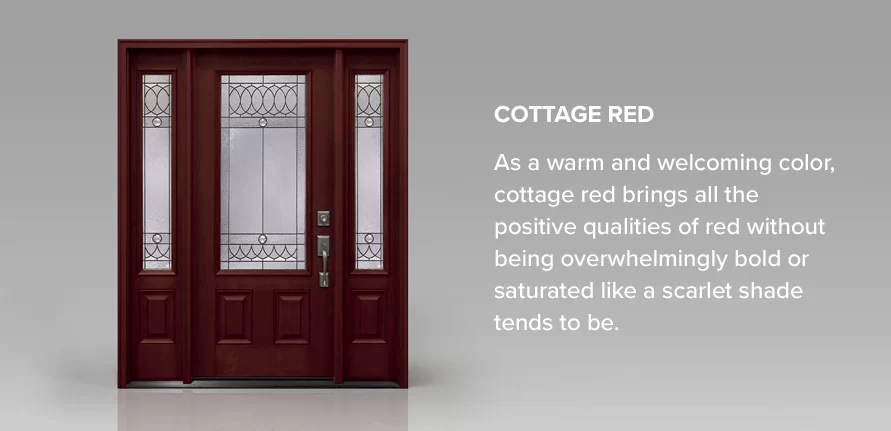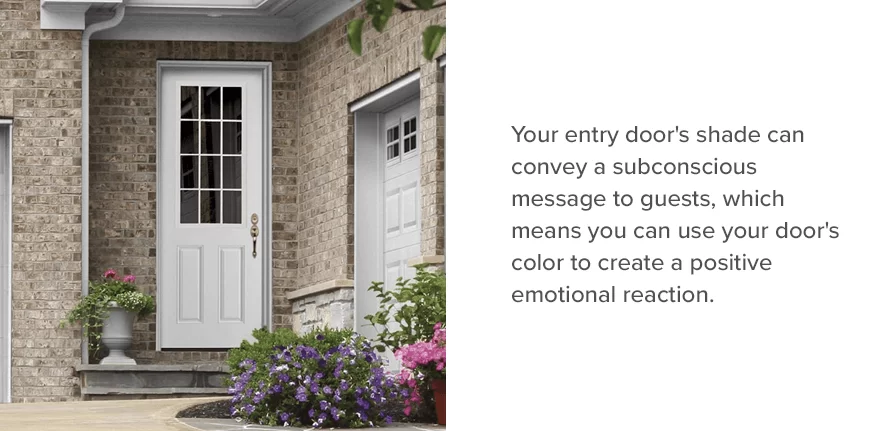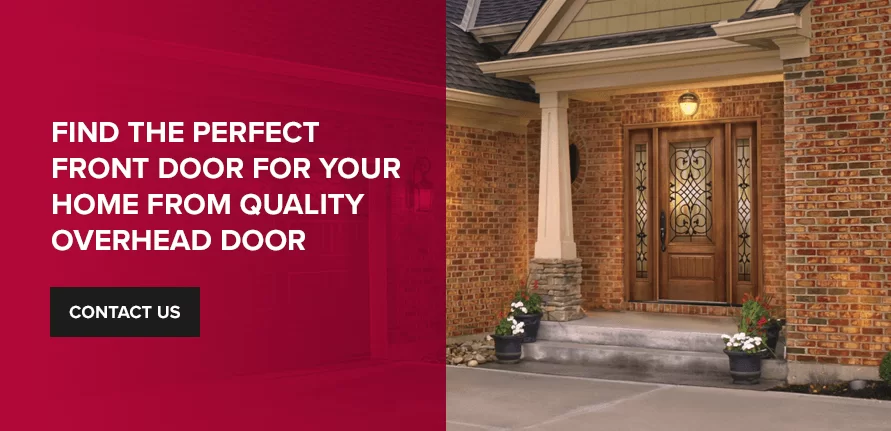With the right coat of paint, the entry door can be the star of a home’s exterior. The front door is the perfect opportunity to add a pop of color and show off both your exterior design skills and your personality. But how do you choose a front door color that stands out without being too over the top?
We’ll help make choosing the color for your front door easier with the guide below. Learn why choosing a paint color for your front door is important, how to pick the right one and how to choose a paint color for your front door that’s in style.
Why Choosing Front Door Paint Color Matters
Before learning how to choose a front door color for your house, you may want to know why selecting the right shade is so important anyway. Because the entry door is such a notable feature of a home’s exterior, there are many reasons choosing the best front door color should be one of your top priorities.
Here are 10 reasons why you should learn how to choose a paint color for the front door:
- It’s one of the first things you see. Your front door is what welcomes you home every single day — the color should have a positive impact on your mood each time you see it.
- It’s one of the first things guests see. An entry door is also a guest’s first impression of your home, and it affects how they feel entering your house.
- It influences your curb appeal. The entry door has a major impact on a house’s curb appeal. Picking colors for your front door that complement the rest of your home can instantly enhance its exterior design.
- It lets you show off your personality. When you choose a front door color, you get to express something about your personality and style.
- It’s a simple home improvement project. Changing your entry door’s color is an inexpensive and easy way to refresh your home’s entire entryway.
- It can influence mood. The color of your front door can produce certain emotions, depending on the hue you choose.
- It makes your home unique. Your entry door’s color allows you to get a bit creative and add a playful touch to your home’s exterior without appearing too gaudy.
- It sets the tone for your home. The hue of your front door will convey something about your home and what guests can expect to find inside of it.
- It’ll set your home apart or help it blend in. The color you choose for your front door can help it blend in with the other houses in your neighborhood or make it stand out.
- It can help sell your home. If you might sell your house soon, painting its entry door with a welcoming or bold color may make it more attractive to potential buyers.
What to Consider Before Choosing Colors for Your Front Door
You might be excited to start looking at all your color options and dreaming about front door designs. But there are a few things you’ll need to consider before you begin browsing paint swatches. Making these considerations early will save you from getting your heart set on an entry door color that isn’t right for your home.
Most importantly, you will need to make sure there are no restrictions on what color you can paint your front door. Some neighborhoods with a homeowners association or Covenants, Conditions and Restrictions (CC&Rs) regulate which exterior paint colors residents can use on homes. The idea is that limiting the range of exterior colors in the neighborhood will create a uniform, cohesive look throughout the community.
Once you know the shades allowed for your front door, the final detail to consider before going over your color choices is your home’s overall exterior theme. You will want to narrow down your color options to only those that fit within your house’s current aesthetic. Only spend time looking at color swatches that will match your home’s primary and trim colors.
10 Tips for Choosing Front Door Color
If it’s time to update your entry door’s look, check out these top 10 tips for how to select a paint color for a front door before making the change.
1. Work With Your Surroundings
If you’re not sure where to start when choosing a front door paint color, try looking at your home’s natural environment to draw some inspiration. Natural earth tones can have striking curb appeal while still fitting in with the house’s surroundings.
The natural lighting around your front door can also help you determine which paint color would look best. If you have a darker porch area, a lighter or bright color will stand out against the darkness. On the other hand, entryways with plenty of light suit a darker color.
2. Stick to Your Style
You will also need to take your home’s structure and exterior design into account when choosing a front door color. The overall style of your home typically dictates which colors would look best on its entry door. For example, a traditional home usually looks best with a classic, dark, rich paint color, whereas a modern home lends itself to a more creative color choice.
Select a front door paint color that complements your home’s other accessories, such as the coloring and style of your garage door. To keep your house’s colors from clashing, consider making your entry door a contrasting color that adds visual appeal to your home. If your house’s exterior is neutral, a bold front door color may provide the contrasting hues your home’s aesthetic needs.
In general, if the materials surrounding your door are dark, a lighter front door color is best and vice versa. However, don’t be afraid to be a little unconventional. Your house is an expression of your personality, so feel free to use your favorite color or signature style if that’s what your heart desires.
3. Choose a Front Door Color Outdoors
Your front door color will be on the exterior of your house, so it makes sense to choose the paint color outdoors. Looking at paint swatches outside will allow you to see how the colors look in settings of natural light. Because interior light can be vastly different from natural lighting, stepping outside to check out colors may greatly affect your final decision.
If you want to be extra confident in your color choice, tape some paint samples to your front door and check them throughout the day. This technique will allow you to see the colors in various lighting conditions. For an even more precise look, you can paint small test patches of the color on your door.
4. Consider the Classics
It’s hard to go wrong with a neutral entry door color like gray, brown or black. These colors are classic hues that will stand the test of time. Even navy blues and deep shades of red are classic front door colors.
If you want to go extremely minimalistic, you can stain your front door instead of painting it. Using a wood stain on your entry door will showcase its natural material or grain pattern if you have a wood door.
5. Make It Monochrome
For those with smaller houses, a monochromatic color scheme will be your new best friend. Painting your home’s front door, window frames, trim and exterior all the same color will visually expand your house to make it appear larger than it really is. A monochromatic color scheme also serves as the perfect neutral backdrop for accessories to stand out against, allowing you to incorporate splashes of color that highlight architectural details.
6. Get Creative
Although using a bright color on your front door might sound intimidating, painting your door is a lesser commitment than painting your entire house or a room that shade. There is no harm in experimenting a bit, so go ahead and try out a bold color that speaks to you. From bright hues of lime green, yellow or orange to darker shades of forest green, eggplant or burgundy, color can be a fun yet sophisticated way to make a stylistic statement.
7. Use the Color Wheel
Even those who never studied art or design are most likely familiar with a color wheel. It’s a helpful reference that displays the relationship among different colors, organizing them into a circle of primary, secondary and tertiary colors. Consulting the color wheel can tell you which colors complement each other and which ones clash.
When comparing the color wheel to your home’s exterior colors, first think about whether you want to stick with a monochromatic color scheme. If so, you can choose darker and lighter shades within the same color. For a more striking contrast, select a door color opposite your house’s main shade on the color wheel.
8. Remember the Trim
Along with the door itself, your front door trim is a candidate for a fresh coat of paint. In general, you should avoid painting your door and trim the same color. Instead, use the trim as an opportunity to introduce a beautiful accent color that pulls together the rest of your house’s exterior.
Although white is a popular and reliable trim color, a contrasting trim color can make your front door really stand out. Rich brown tones can bring some warmth to a cool-colored entry door. A dark-colored trim can also keep a light-colored front door from fading into its surroundings. On the other hand, a lighter-toned trim can add some much-needed brightness to a dark-colored door.
9. Don’t Forget Your Screen Door
If your front door has a screen door or a storm door, consider painting its frame or purchasing a new one in a contrasting hue for a double-dose of color. Especially if you chose a more neutral tone for your front door, the frame of your screen door can be a chance to add a bit of pizzazz to your home’s exterior. Whether you want to add a pop of bold color or not, remember to pick an accent color for your screen door.
10. Pick the Right Paint
Because your door has to face the outdoor elements every day, use the right type of paint to avoid peeling and fading in the future. For example, a steel entry door could benefit from a paint with built-in rust protection. In general, latex exterior paints offer weather-resistant coverage for a wide range of conditions.
Regardless of the type of paint you select, you will need to coat your entry door with an exterior primer first. Then you can choose a front door paint with the finish of your choice, including matte, semi-gloss, glossy and high-gloss finishes. Unless you have an extremely high-quality front door, a high-gloss finish will bring out the blemishes. You may want to opt for a semi-gloss paint, which is more forgiving and will hide your front door’s flaws.
How to Select a Front Door Color That’s Trendy
Now that you know the basics of how to choose a color for a front door, know what color door to select to make your entryway pop. If you want to ensure your house is the coolest one on the block, you’ll need a front door color that’s trendy. The current trends in exterior design can point you toward the perfect entry door hue for your home.
If you want a front door that’s in fashion, check out these chic color choices:
Navy Blue
Navy blue is the perfect hue for any homeowner who wants their door to have the traditional feel of a neutral color yet stand out among other front doors. By providing a more modern take on a conventional color, navy blue manages to appear classic and fresh at the same time. From deep nautical blue to softer, more subtle shades, the right navy blue for your home’s exterior design is out there.
Sage Green
Sage green is a well-balanced color that can effortlessly blend in with a more natural environment or catch people’s eye in a more urban setting. Because sage green is so adaptable, it’s the ideal accent color for a front door. A sage green door also has the calming effect of a neutral while distinguishing a home with a dash of color.
Cottage Red
A cheerful red door could be enough to raise your spirits every time you walk into your home. As a warm and welcoming color, cottage red brings all the positive qualities of red without being overwhelmingly bold or saturated like a scarlet shade tends to be. A smooth fiberglass front door is a perfect style for cottage red because the elegant glass artfully breaks up the strong color.
Earthy Clay
If you like red as a front door color but want to be a bit different, an earthy clay hue is the solution you’ve been searching for. Shades of earthy clay feel both welcoming and grounded while pairing well with warm, neutral colors. If your home’s exterior is a neutral color like white or cream, consider choosing an earthy clay entry door to add a touch of color that isn’t excessively bold.
Poppy Orange
Orange can be another refreshing twist on the classic red door. In particular, a reddish-orange shade like poppy orange can provide the perfect balance of the bright hue with deep red undertones. Orange is also a versatile entry door color, as it can be a warm complement for a rustic wood front door or a fun accent color for sleek urban homes.
Blush Pink
Blush pink offers a more mature take on the pastel tones that typically come to mind when we picture pink. A blush pink front door can contribute a hint of softness to your home’s exterior while maintaining its sophisticated style overall. Specifically, blush pink pairs excellently with neutral home exteriors like beige, gray and white.
Forest Green
A deep forest green is a classic hue with a distinct flair, and it can breathe new life into your home’s exterior design. Forest green is a great match for red brick homes, creating a lovely traditional look. It also suits homes and cabins surrounded by trees, as the color perfectly complements the surrounding greenery and natural beauty.
Turquoise
A turquoise front door instantly sparks visual appeal while maintaining a natural tie to the blue of the sky. This hue shows you’re a grounded person who enjoys just a touch of whimsy. As a relaxing and inviting color, turquoise also welcomes guests inside and makes them feel comfortable. Consider pairing your eye-catching turquoise door with a more neutral color, such as gray, beige or taupe.
Eggplant Purple
To make your front door truly stand out, pick a purple hue. Although purple is one of the more rare colors for an entry door, a deep shade of eggplant is a great way to embrace your open-minded and creative side. But eggplant still maintains the sophisticated aesthetic of your home’s exterior design. An eggplant purple front door suits any neutral exterior color, such as gray, beige, taupe, white or olive green.
What Color Should I Choose for My Front Door?
Ultimately, the color of your front door should accurately portray your distinct style and unique personality. Because colors have the power to influence our mood, choosing your front door paint color is a major decision. Your entry door’s shade can convey a subconscious message to guests, which means you can use your door’s color to create a positive emotional reaction.
Knowing how to choose a front door paint color that fits your personality means understanding the psychology of color first. This list of the most popular front door colors explores their psychological impact:
- Blue: Blue is a calming option, signifying a tranquil home with an easygoing homeowner. Blue also goes well with many other colors.
- White: A white front door is a classic choice for traditional homes and gives the impression that the homeowner keeps a tidy, well-organized house.
- Red: A bold red entry door will help a home stand out. As a bonus, red is regarded as a lucky color in some cultures.
- Green: As a key color found in nature, green is a harmonious hue. A green front door indicates a peaceful home with a friendly owner.
- Yellow: Like sunshine, yellow is cheerful and overflowing with optimism. A yellow entry door will naturally draw people in.
- Black: As a traditional, sophisticated and elegant door color, a black front door shows passersby that the homeowner has a refined taste. This dark shade suggests the interior of the home is equally classy.
- Orange: An adventurous orange front door advertises that a spontaneous, confident and extroverted homeowner lives inside.
- Purple: A whimsical purple front door demonstrates the homeowner’s free spirit and will make guests smile when they enter.
Find the Perfect Front Door for Your Home From Quality Overhead Door
If you’re looking for the front door of your dreams, Quality Overhead Door has the residential entry door selection you need. We offer a wide range of front door designs made from premium natural wood, stylish steel or low-maintenance fiberglass. Along with being extremely durable, our entry doors come in an array of attractive colors so you can find the perfect hue for your home.
As a family-owned business that’s been serving Toledo since 1982, Quality Overhead Door knows exterior home design. Our experienced team will provide you with a visually stunning, long-lasting front door you can enjoy for years to come.
To find out more about entry door styles and how to choose the color of your front door, contact Quality Overhead Door today.
Additional Resources on Entry Doors:
- What are the Parts of Front Door
- Entry Door Buyer Guide
- What Size is a Standard Front Door
- How to Choose a Front Door Style

